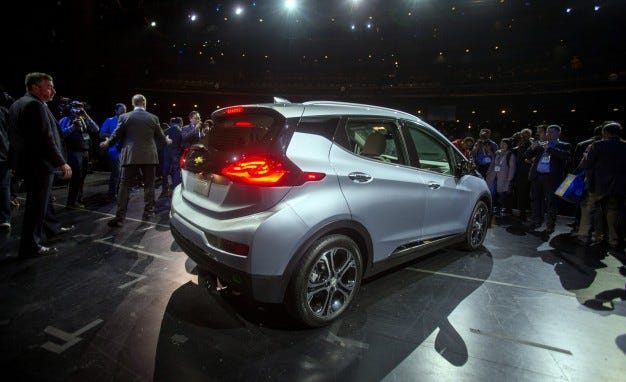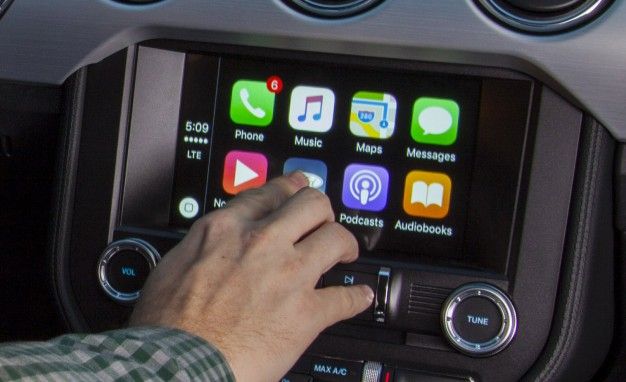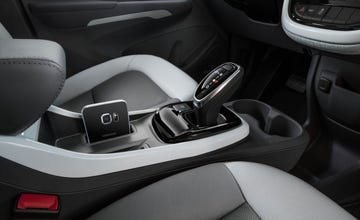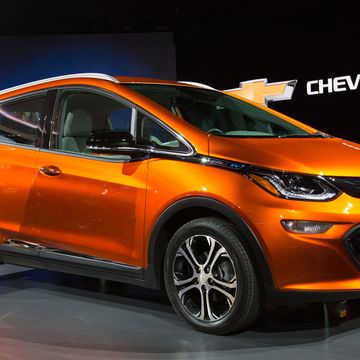In between fantastical distractions at this year’s Consumer Electronics Show like Faraday Future’s 1000-hp electric concept and car–drone integrations sat a very real auto-industry awakening to the massive show’s importance. Automakers have for years attended CES, one of the most-attended trade shows in the country, but 2016 marks the first year every attending automaker treated the event as a de facto auto show. General Motors CEO Mary Barra personally unveiled the 2017 Chevrolet Bolt EV; VW rolled out its highly anticipated electric microbus redux; and Kia announced a new sub-brand for is autonomous-driving features. More important than those headlines, automakers and suppliers trumpeted a chorus of future-tech themes, so after a week of being assaulted with autonomous driving! mobility! connectivity! and The Internet of Things!, we’ve distilled what the show really means for you and the cars you’ll buy in the coming years.
It doesn’t really matter whether automakers chose to go full buzzword at CES this year because they felt it made them fit in among the Silicon Valley set, or simply because inscrutable jargon sounds “techy.” Their bleating can all be boiled down to a simple goal: To inter-connect vehicles, smartphones, wearable devices, and even your home while also giving the car more autonomous capability. This, it’s said, will make life easier by removing the effort humans must put toward pretty much anything that can’t be handled by an app. Automakers aren’t doing this because they want in on the Fitbit or Candy Crush Saga markets, they’re jumping in headlong in order to remain relevant in a world rapidly shifting toward the electronically ephemeral. This, after a the strongest year of car sales ever.
GM Gets Cozy with Lyft
Just look at General Motors’ massive investment in ride-sharing service Lyft, a company working toward automating cars and turning them into robot taxis. (Why not Uber, which also aims to develop self-driving taxis? It’s currently valued at over $60 billion—it’s unlikely GM’s $500 million would matter much over there.) The investment gives Lyft access to GM’s autonomous-car tech, and yet the development of a fully autonomous car taxi would seem to work against GM’s efforts toward selling cars. Why bother owning a car when a autonomopod can be summoned by your phone? Perhaps the Lyft deal is shrewder than it appears. In the near term GM’s half a billion dollars makes it a preferred provider of Lyft vehicles, as well giving it a foot in a next-generation mobility company’s front door. And just maybe, by relegating fully autonomous cars to taxi duty, GM is hoping regular customers will still want normal ones lest they be caught owning—gulp—a taxi?
All Connected Now
As for the connectivity and Internet of Things buzzwords, these, too, are automakers’ grasps at relevance. People are spending more and more time on their devices, and they want all of those disparate widgets connected. Increasingly internet-enabled home thermostats, appliances, security systems, and TVs are ripe for networking and automation, and the possibilities are endless. Imagine your fridge inventorying your foodstuffs for you, so that when you’re at the grocery store and can’t remember if there’s still beer at home, your phone can tell you in seconds. Cars can play a role in all of this, should automakers choose to participate. Your home could pre-heat itself and switch on the lights as your evening commute draws to a close, or your car could fire up in the morning and turn on the defroster as soon as you flick on your coffee maker. This sort of automation is merely lines of code (and seriously decked-out homes) away from reality. They’re certainly front of mind for BMW, Bosch, Ford, and Volvo, each of which showed off car-to-home, car-to-wearable, or car-to-phone connected concepts.
In-Car Entertainment
Partly, automakers’ enhanced connectivity goals also aim to address the issue of how people will entertain themselves in the self-driving cars of the future. Assume that the development of the self-driving car won’t lead to a two-party Lyft/Uber mobility takeover and that individual ownership of four-wheeled transport perseveres. Even regular cars will someday offer fully autonomous capability—and why watch House of Cards on your phone, head cocked down, when you could view it in glorious high definition on a giant in-dashboard display? Volvo tackled this possibility at CES from the infrastructural side, revealing how it and wireless provider Ericsson plan to investigate streaming high-def video to self-driving cars. Upstart EV manufacturer Faraday Future took a different route, stuffing its FFZero1 concept car with multiple large displays that someday may be conduits for the company’s Chinese backer, LeTV, to stream its prodigious content library into the car. LeTV is like China’s Amazon or Netflix, and you can bet it’d like to serve ads to cars in addition to tablets, TVs, and laptops. LeTV is no flash in the pan, either—it has an ongoing development deal with Aston Martin to research EVs.
Near-Term News
Not everyone went full moonshot at CES this year, as there were plenty of near-term tech developments that debuted, too. Ford added Apple CarPlay and Android Auto phone-mirroring to its Sync 3 infotainment platform, as well as a 4G LTE data connection like General Motors has had for over a year. Chrysler, too, added CarPlay and Android Auto into its Uconnect head units. Volkswagen introduced an enhanced infotainment platform that incorporates simple gesture controls like those on BMW’s flagship 7-series sedan.
- BMW Probes for New Levels of Life-Machine Interfacing With Internet of Things Concept Tech
- Faraday Future FFZERO1 Concept: A Wild, 1000-hp Electric Spaceship that Previews Production EVs (Maybe)
- 2016 Consumer Electronics Show Full Coverage: Every Debut and Tech Development
For customers today, phone integration is nearly as important as how a car drives, making the technologies of right-now more relevant than a video-streaming self-driving car that knows how to chat up your house. Yet mix in the medium-term Internet of Things with the far-out autonomous tech, and automakers have crafted a clear path forward into the tech-laden world of tomorrow. Whether the auto world’s increasing concession toward the digital world will someday be its undoing remains to be seen, but the 2016 CES proves the industry’s going to fight for relevancy regardless. Next year, we expect even more brands to appear in the Vegas convention center’s North Hall, which has long been cordoned off for predominantly automotive use. Is it too poetic to point out that, although it is the smallest of the Las Vegas Convention center’s three blimp-hangar-sized halls, North Hall offers perhaps twice the floor space of the North American International Auto Show’s home in Detroit’s Cobo Center? Yep, the automotive calendar no longer begins in the Motor City—it kicks off the week before, under the gleaming lights of Las Vegas, baby.










